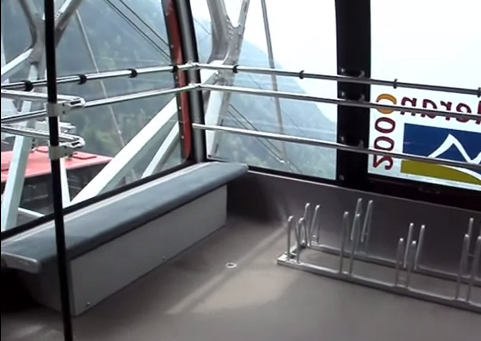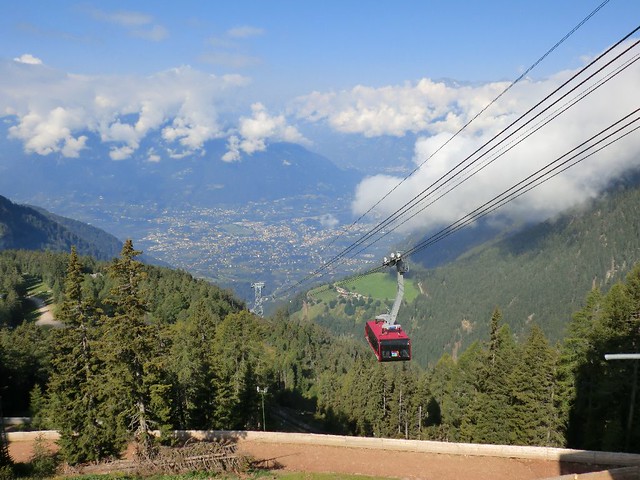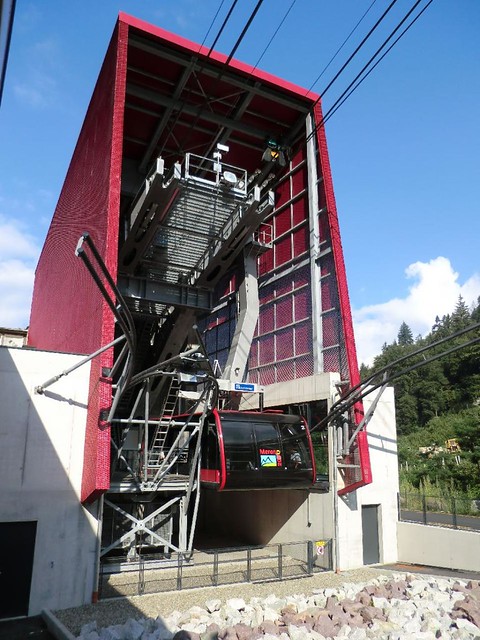There is more than one intriguing feature to the Meran 2000 Bergbahn, an aerial ropeway built in 2010 at the Merano 2000 ski resort in South Tyrol, Italy. At first the it may appear to be a simple (yet stunning) two-cabin tram — the stations are small, the system branded a vibrant red, and the cabins large (each cabin can hold 120 people.) But there’s more…
THE MID-STATION
First off, the system has three stations, not just two. And even more interestingly the mid-station consists of an underground waiting area, a large lattice pylon (tower), and a bridge. Yes, I said a bridge. Essentially, because of the alignment, the mid-point is located in a rather difficult location (apparently mid-air?)
Instead of constructing a really tall station that would reach to the ground below (which would be more costly and require a larger footprint) or re-aligning the system, engineers decided to span the distance between the cabins and nearest parallel mountainside with a large metal and cantilever (with support) bridge.

Now, when I say cabins, I mean cabin. The other point to this design is that as far as I can tell, only one cabin can utilize the mid-station since the bridge only reaches as far as one side of the tower. This is more obvious in the diagram below.

The bridge is entirely static except for the last bit which folds down for the approaching cabin once it has come to a complete stop. You can see the bridge in action in this video (or here):
Another intriguing aspect to the mid-station is that the cabins only stop when requested. If everyone is going to the top (or bottom) station, the system will continue past the mid-station/bridge. Only when the “request a stop” button is pushed does the cabin stop. (This reminds me of some other form of transit … oh right, buses and streetcars!)
THE MAIN STATIONS
As previously mentioned, the Merano Bergbahn stations are small. And by small I mean really narrow. Since the system is a reversible aerial tram there can never be more than one cabin at each end station at any given time. Therefore to save space the loading/unloading platforms in these stations are moveable, sliding back and forth depending on which side the cabin is on.
Other than being really awesome, a big reason for the small size (at least at the bottom station) was to stay away from the river, which would have led to additional complications and cost. If station sizes can be reduced to avoid naturally occurring obstacles, imagine how they could be designed to fit into urban contexts…
THE ARCHITECTURE
Finally, the last point to note is the architecture, which is really rather striking.
The top and bottom stations are mostly concrete but clad in a ruby red metal mesh. The top station also has a bistro which is almost entirely surrounded by windows — I can only imagine that the view is spectacular.
FINAL NOTE
As a final observation, one video I watched showed the inside of one of the cabins. And it was equipped with a bike rack, which seemed rather appropriate to point out especially as a feature for urban systems and as a follow up to a recent guest post about bikes on transit. In this case it is definitely a feature that seems like it could be removed for the winter to allow more room for people and skis.

The Merano 2000 biker friendly aerial trams
In conclusion, if you’ve ridden on this system or have anything to add, tell us in the comments! We’d love to hear your thoughts.






5 Comments
That little hook like thing that swings out to push the cabin into the fold down bridge was unexpected.
And I like the bike racks.
Very cool system.
I love the bridge – really smart design. Looks a tad precarious though.
More precarious than a box on a rope?
This system has some very interesting features – obviously the rather unique middle station but also the movable loading/unloading platforms; that is very different!
I presume this design means that if you want to get off at the middle station and the departing cabin is on the wrong side you would have to wait for the next cabin…
A small point; I don’t even know if it’s worth mentioning. The middle station doesn’t appear to be exactly halfway. In one of the photos of the cabins at the middle station the far cabin appears to be slighly offset (slightly downhill of the middle station). I would assume that this is due to the terrain below the cables not being suitable at the exact midway point. Perhaps another reason why the middle station only serves one direction?
Also, the aesthetic design of the whole system is superb!
Great coverage of a fantastic system. Still trying to figure out how the stations “move” to accommodate both directions, but… maybe someone could find a video at some point.
Great visual look of the stations – it really “pops” at night too.